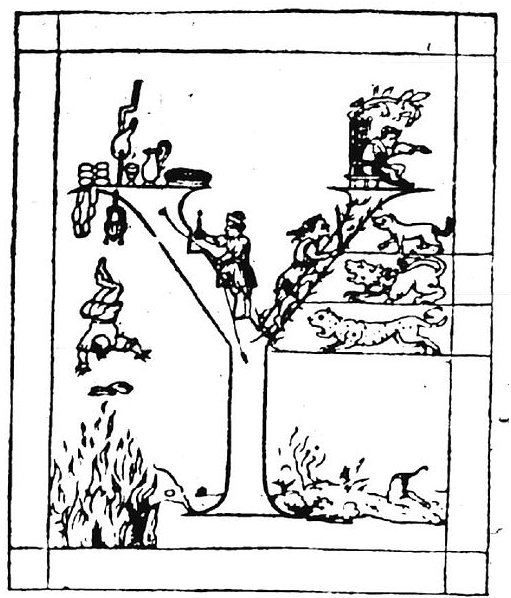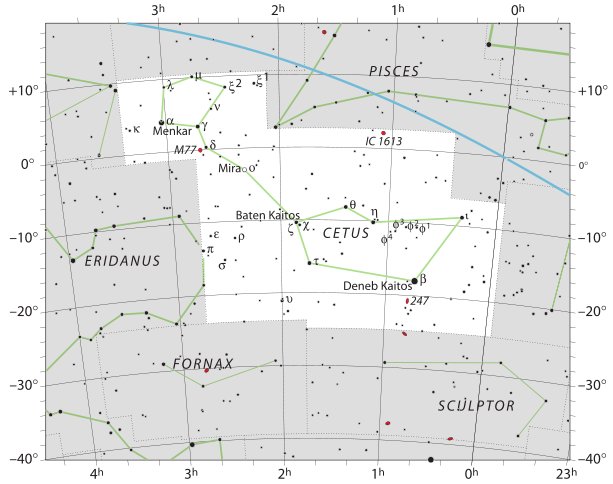Neither ψ nor ω can be found in the
star map for Cetus:
On the other hand: There are 4 stars
φ in
Al Nithām, the Necklace, and
there is also a pair
of ξ stars. 24 (Greek letters in the
alphabet) - 2 = 22 and 22 + 3 + 1 =
26. So far I have only 5 Ceti stars
in my list and 21 should now be added:
|
ι |
00h19m25.68s |
00h19.428m |
4.3 |
|
Deneb Kaitos |
00h43m35.23s |
00h43.587m |
10.4 |
|
φ╣ |
00h44m11.41s |
00h44.190m |
10.6 |
|
φ▓ |
00h50m07.72s |
00h50.129m |
12.1 |
|
φ│ |
00h56m01.51s |
00h56.025m |
13.6 |
|
φ4 |
00h58m43.89s |
00h58.732m |
14.2 |
|
η |
01h08m35.26s |
01h08.588m |
16.7 |
|
θ |
01h24m01.45s |
01h24.024m |
20.7 |
|
τ |
01h44m05.13s |
01h44.086m |
25.7 |
|
χ |
01h49m35.19s |
01h49.587m |
27.1 |
|
υ |
02h00m00.22s |
02h00.004m |
29.8 |
|
ξ╣ |
02h13m00.01s |
02h13.000m |
33.1 |
|
ρ |
02h25m57.01s |
02h25.950m |
36.4 |
|
ξ▓ |
02h28m09.52s |
02h28.159m |
36.9 |
|
σ |
02h32m05.28s |
02h32.088m |
37.9 |
|
ν |
02h35m52.49s |
02h35.875m |
38.9 |
|
δ |
02h39m28.95s |
02h39.483m |
39.8 |
|
ε |
02h39m33.73s |
02h39.562m |
39.8 |
|
π |
02h44m07.35s |
02h44.123m |
41.0 |
|
μ |
02h44m56.37s |
02h44.940m |
41.2 |
|
λ |
02h59m42.90s |
02h59.715m |
44.9 |
|
κ |
03h19m21.54s |
03h19.359m |
49.9 |
When
calculating the right
ascension numbers I
noticed how they in Cetus
were as if by magic
exhibiting several of our now well known
calendar numbers.
For instance was the
first Greek lettered star in Cetus (ι)
at Gb3-14 (day 384 at the time of
the Hyades Gate):
 |
 |
 |
|
 |
 |
 |
|
Gb3-11 |
Gb3-12 |
Gb3-13 |
Gb3-14
(75) |
Gb3-15 |
Gb3-16
(306) |
|
JANUARY
16 |
17 |
18 |
19 (384) |
20 |
21 |
|
Al
Fargh al
Thāni-25 |
Uttara
Bhādrapadā-27
/
Wall-14 |
χ Pegasi
(2.1), θ
Andromedae
(2.7) |
σ
Andromedae
(3.0),
ι
Ceti
(3.3), ζ
Tucanae
(3.5),
ρ
Andromedae,
π
Tucanae
(3.7) |
no star
listed
(4) |
Ankaa, κ
Phoenicis
(5.0)
Alphard |
|
0h
(365.25) |
|
Caph,
SIRRAH
(0.5), ε
Phoenicis
(0.8) |
ALGENIB
PEGASI
(1.8) |
|
March 21
(0h) |
22 |
23 |
24 |
Equinox
(84) |
26 (450) |
|
░March
17 |
18 |
19 |
20 |
░March
21 (0h) |
22 |
|
'February
22 |
Terminalia |
Bissextum
(*340) |
25 (56) |
26 (422) |
27 |
|
"February
8 |
9 (40) |
10
(*326) |
11 |
12 (408) |
13 |
|
NAKSHATRA
DATES: |
|
JULY 18 |
19 (200) |
20
(*121) |
|
21 |
22-7 |
23
|
|
Alchita,
Ma Wei
(183.1),
Minkar
(183.7),
ρ
Centauri
(183.9) |
Pßlida
(184.6),
Megrez
(184.9) |
Hasta-13
/
Chariot-28 |
Chang
Sha
(186.3) |
Intrometida
(187.4),
Acrux
(187.5) |
γ Com.
Berenicis
(188.0),
σ
Centauri
(188.1),
Algorab
(188.5),
Gacrux
(188.7)
|
|
GIENAH
(185.1),
ε Muscae
(185.2),
ζ Crucis
(185.4),
Zaniah
(185.9) |
|
September
20 |
21 |
Equinox
(265) |
23 |
24 |
25 |
|
░September
16 |
17 |
18 |
19 |
20 |
21
(*184) |
|
'August
24 (236) |
25
(*157) |
26 |
27 |
28 |
29 |
|
"August
10 (222) |
11 |
12
(*144) |
13 |
14 |
15 |
 |
 |
 |
|
Gb3-17 |
Gb3-18
(308) |
Gb3-19
(80) |
|
JANUARY
22 |
23 (388) |
24 |
|
λ
Phoenicis
(6.3), β
Tucanae
(6.4) |
Andromeda
Galaxy,
π
Andromedae
(7.7) |
ε
Andromedae
(8.2),
Delta
(8.4),
Schedir
(8.6),
ζ
Andromedae,
μ
Phoenicis
(8.9) |
|
March 27 |
28 (452) |
29 (88) |
|
░March
23 |
24 (448) |
25 (84) |
|
'February
28 |
'March 1
(425) |
2 (61) |
|
"February
14
(2-14) |
15 (46) |
16
(*332) |
|
NAKSHATRA
DATES: |
|
JULY 24 |
25 (206) |
26
(*127) |
|
γ Muscae
(189.0),
Avis
Satyra
(189.3),
Asterion
(189.5),
Kraz
(189.7) |
α
Muscae
(190.2),
τ
Centauri
(190.5),
χ
Virginis
(190.7)
Alderamin |
Al
┴wwā'-11
/
Shur-mahrū-shirū-19 |
|
Sombrero
Galaxy
(191.1),
ρ
Virginis
(191.4),
PORRIMA,
γ
Centauri
(191.5) |
|
September
26 |
27 (270) |
28 |
|
░September
22
(*185) |
23 |
24 |
|
'August
30 (242) |
31 |
'September
1 (*164) |
|
"August
16
(*148) |
17 |
18 (230) |
 |
 |
 |
 |
|
Gb3-20
(310) |
Gb3-21 |
Gb3-22 |
Gb3-23
(84) |
|
JANUARY
25 (390) |
26 |
27 |
28 |
|
ξ
Phoenicis
(9.0), ρ
Tucanae
(9.1),
Deneb
Kaitos,
η
Phoenicis
(9.4),
Al
Nithām
(9.5) |
Achird
(10.7) |
Legs-15 |
Cih,
λ
Tucanae
(12.4),
φ│ Ceti
(12.6),
μ
Andromedae
(12.8) |
|
ν
Andromedae
(11.0),
φ▓ Ceti
(11.1),
ρ
Phoenicis
(11.2),
η
ANDROMEDAE
(11.4) |
|
March 30 |
31 (90) |
April 1 |
2 (457) |
|
'March 3 |
4 (428) |
5 (64) |
6 (*350) |
|
"February
17 |
18 (414) |
19 (50) |
20
(*336) |
|
NAKSHATRA
DATES: |
|
JULY 27
(*128) |
28 |
29 (210) |
30 |
|
ι Crucis
(192.2),
β Muscae
(192.5),
Mimosa
(192.9) |
no star
listed
(193) |
κ Crucis
(194.4),
ψ
Virginis
(194.5),
μ
Crucis,
λ Crucis
(194.6),
Alioth
(194.8) |
Minelauva
(195.1),
Cor
Caroli
(195.3) |
|
September
29 (272) |
30 |
October
1 |
2 |
|
'September
2 (*165) |
3 |
4 |
5 (248) |
|
"August
19
(*151) |
20 |
21 |
22 (234) |
 |
 |
 |
|
Gb3-24
(314) |
Gb3-25 |
Gb3-26
(87) |
|
JANUARY
29
(*314) |
30 |
31 (396) |
|
φ4
Ceti
(13.2) |
no star
listed
(14) |
1h
(15.2) |
|
β
Phoenicis
(15.1),
υ
Phoenicis,
ι
Tucanae
(15.6), η
Ceti, ζ
Phoenicis
(15.7) |
|
April 3
(93) |
4 |
5 (460) |
|
'March 7
(*351) |
8 |
9 (68) |
|
"February
21 (52) |
22 (418) |
Terminalia |
|
NAKSHATRA
DATES: |
|
JULY 31
(*132) |
AUGUST 1 |
2 (214) |
|
δ Muscae
(196.5),
Vindemiatrix
(196.8) |
13h
(197.8) |
Apami-Atsa,
ψ Hydrae
(198.5) |
|
ξ╣
Centauri
(197.1),
ξ▓
Centauri
(197.9) |
|
October
3 |
4 (277) |
5 |
|
'September
6 |
7 (250) |
8 (*171) |
|
"August
23 |
24 (236) |
25
(*157) |
In
Manuscript E many pages were needed
for a complex story involving
surfing towards land, holes
in stones, stone figures, mother of
pearl ornaments, necklaces, and
other re-markable details. The
position was the western side of the
land, beyond Ahu Akapu the
last of the kuhane
stations, and probably the myth here
re-counted the border between the
old and new years.
... He went back out into the sea,
and the movement of the wave was to
the left side. Again he glanced,
this time in the direction of Pu,
and the ornament of Pu shone
brightly. [Pu was the name of
the place with a hole in the stone
at Apina Nui. Maybe Pi(i)
was meant to be the opposite of
Pu, as when right is contrasted
with left.] Again he went out into
the sea. From the middle, the two
necklaces around the neck of the two
figurines shone (toward him). His
ride on the wave ended in Rio,
and therefore the name 'Hanga O
Rio' was given. [There were 2
necklaces, but the story recounts
only how one of them was used around
the neck of the stone figure
Apina Iti. The other stone
figure was Rapa Kura and
nothing is said if also this figure
was buried up to her neck or not.
Instead the name of the Apina Iti
figure was strangely changed to
Apina Iti A Rapa Kura. If
Barthel has translated the story
correct, then it contains puzzles to
solve. Was the Apina Iti
statue joined to the Rapa Kura
statue when he got the necklace
around his neck? But then the name
changed again, this time to
Hinariru, the son of Tuu
Hokorua, where indeed the latter
name is in harmony with my question
- 'in a group of two'.] Ira
remained on shore, pondered, and
said, 'This is well done! Ruhi
to the right, Pu to the left,
and Hinariru Nui and
Hinariru Iti in the middle.'
...

Hevelius has only 3 necklace stars
(between ι and η):

 |
 |
 |
 |
|
Gb3-27
(88) |
Gb3-28 |
Gb3-29 |
Gb3-30 |
|
FEBRUARY
1 (32) |
2 |
3 |
4 (400) |
|
Al Batn
Al
Hūt-26 /
Revati-28 |
ν
Phoenicis
(17.4),
κ
Tucanae
(17.6) |
no star
listed
(18) |
Adhil
(19.3),
θ Ceti
(19.7) |
|
MIRACH,
Keun Nan
Mun
(16.0),
Anunitum
(16.5),
REVATI
(16.9)
Regulus
|
|
April 6
(*16) |
7 |
8 |
9 (464) |
|
'March
10
(*354) |
11 |
12 |
13 (72) |
|
"February
24
(*340) |
25 |
26 |
27 (58) |
|
NAKSHATRA
DATES: |
|
AUGUST 3 |
4 |
5 |
6 (218) |
|
Al
Dafīrah
(199.4) |
σ
Virginis
(200.4) |
γ Hydrae
(201.0),
ι
Centauri
(201.4) |
Al
Simāk-12
/
Chitra-14
/
Horn-1 /
Sa-Sha-Shirū-20
ANA-ROTO |
|
Mizar
(202.4),
SPICA,
Alcor
(202.7)
Sadalmelik |
|
October
6 |
7 (280) |
8 |
9 |
|
'September
9 (*172) |
10 |
11 |
12 (255) |
|
"August
26 |
27 |
28 (240) |
29
(*161) |
Beyond heliacal
θ Ceti was April
10 (100) and the
beginning of a
new glyph line.
There were 4
days with no
Sea Beast star and then
came not only
Baten Kaitos (ζ)
but also τ and χ
- letters with
approximately
the same
meaning:
 |
 |
 |
 |
|
Gb4-1 |
Gb4-2
(93) |
Gb4-3 |
Gb4-4
(324) |
|
FEBRUARY
5
(36) |
6
(*322) |
7
(403) |
8 |
|
Ksora
(20.1),
ω
Andromedae
(20.6),
γ
Phoenicis
(20.8) |
δ
Phoenicis
(21.5) |
υ
Andromedae
(22.9) |
Achernar
(23.3),
χ
Andromedae
(23.6),
τ
Andromedae
(23.9) |
|
April
10
(100) |
11
(466) |
12 |
4-13 |
|
3-14 |
'March
15 |
16
(*360) |
17
(441) |
|
"February
28 |
"March
1
(60) |
2 |
3
(427) |
|
NAKSHATRA
DATES: |
|
AUGUST
7 |
8
(*140) |
9 |
10
(222) |
|
71
Virginis
(203.6) |
no
star
listed
(204) |
Heze
(205.0),
Southern
Pinwheel
Galaxy
(205.7) |
ε
Centauri
(206.3) |
|
October
10 |
11 |
12
(285) |
13 |
|
'September
13 |
14
(*177) |
15 |
16
(259) |
|
"August
30
(242) |
31 |
"September
1
(*164) |
2 |
 |
 |
 |
|
Gb4-5
(325) |
Gb4-6
(97) |
Gb4-7 |
|
FEBRUARY
9
(40) |
10
(*326) |
11
(407) |
|
τ
Ceti
(24.7) |
no
star
listed
(25) |
ANA-NIA |
|
χ
Ceti
(26.1),
POLARIS,
Baten
Kaitos
(26.6),
Metallah
(26.9) |
|
4-14 |
April
15 |
16
(106) |
|
'March
18 |
19
(78) |
20
(*364) |
|
"March
4 |
5
(64) |
6
(*350) |
|
NAKSHATRA
DATES: |
|
AUGUST
11
(223) |
12
(*144) |
13
(590) |
|
no
star
listed
(207) |
τ
Bootis
(208.2),
Benetnash
(208.5),
ν
Centauri
(208.7),
μ
Centauri,
υ
Bootis
(208.8) |
no
star
listed
(209) |
|
October
14 |
15
(288) |
16 |
|
'September
17
(260) |
18 |
19
(*182) |
|
"September
3 |
4 |
5
(248) |
| Egyptian sticks |
 |
Phoenician taw |
 |
Greek chi |
Χ (χ) |
| Greek tau |
Τ (τ) |
|
In Plato's Timaeus, it is explained that the two bands that form the soul of the world cross each other like the letter Χ.

Chi or X is often used to abbreviate the name Christ, as in the holiday Christmas (Xmas). When fused within a single typespace with the Greek letter Rho, it is called the labarum and used to represent the person of Jesus Christ. (Wikipedia)

... tau is the 19th letter of the Greek alphabet. In the system of Greek numerals it has a value of 300 ... Taw is believed to be derived from the Egyptian hieroglyph meaning 'mark' ...
Taw, Tav or Taf is the twenty-second and last letter in many Semitic abjads ... In gematria Tav represents the number 400, the largest single number that can be represented without using the Sophit forms ...
'From Aleph to Taf' describes something from beginning to end; the Hebrew equivalent of the English 'From A to Z' ...
Tav is the last letter of the Hebrew word emet, which means truth. The midrash explains that emet is made up of the first, middle, and last letters of the Hebrew alphabet (Aleph, Mem, and Tav...). Sheqer (falsehood), on the other hand, is made up of the 19th, 20th, and 21st (and penultimate) letters.
Thus, truth is all-encompassing, while falsehood is narrow and deceiving. In Jewish mythology it was the word emet that was carved into the head of the Golem which ultimately gave it life. But when the letter 'aleph' was erased from the Golem's forehead, what was left was 'met' - dead. And so the Golem died ... (Wikipedia)

|
The letter
of
Pythagoras
(Υ) was used
at glyph
329, between
Sheratan and
Alrisha, and
the falling
figure
with
υ-formed
tail could
possibly refer to the
left path
- and maybe
also a
plunge into
the
beginning of
the river of
Eridanus:
 |
 |
 |
 |
 |
|
Gb4-8
(99) |
Gb4-9
(329) |
Gb4-10 |
Gb4-11 |
Gb4-12 |
|
FEBRUARY
12
(408) |
13 |
2-14
(45) |
15 |
16 |
|
Al
Sharatain-1
/
Ashvini-1
/
Bond-16
/
Mahrū-sha-rishu-ku-2 |
ι
Arietis
(28.0),
λ
Arietis
(28.2),
υ
Ceti
(28.8) |
Alrisha,
χ
Phoenicis
(29.2),
Alamak
(29.7) |
Arku-sha-rishu-ku-3 |
η
Arietis
(31.9) |
|
2h
(30.4) |
|
Segin,
Mesarthim,
ψ
Phoenicis
(27.2),
SHERATAN,
φ
Phoenicis
(27.4) |
κ
Arietis
(30.3),
HAMAL
(30.5)
Alkes |
|
April
17
(107) |
18 |
19 |
20 |
21 |
|
'March
21
(0h) |
22 |
23 |
24
(*368) |
25
(84) |
|
"March
7 |
8 |
9 |
10
(*354) |
11
(70) |
|
NAKSHATRA
DATES: |
|
AUGUST
14 |
15
(227) |
16
(*148) |
17 |
18 |
|
Muphrid
(210.1),
ζ
Centauri
(210.3) |
φ
Centauri
(211.0),
υ╣
Centauri
(211.1),
υ▓
Centauri
(211.8),
τ
Virginis
(211.9) |
Agena
(212.1),
θ
Apodis
(212.5),
Thuban
(212.8) |
14h
(213.1) |
Neck-2 |
|
π
Hydrae,
χ
Centauri
(213.0),
Menkent
(213.1) |
Asellus
Tertius,
κ
VIRGINIS,
14
Bootis
(214.8) |
|
October
17
(290) |
18 |
19 |
20 |
21 |
|
'September
20 |
21 |
Equinox
(265) |
23
(*186) |
24 |
|
"September
6 |
7
(250) |
8 |
9
(*172) |
10 |

... In the
story of
PhaŰton,
which is
another name
for
Helius
himself
(Homer,
Iliad
xi. 735 and
Odyssey
v. 479), an
instructive
fable has
been grafted
on the
chariot
allegory,
the moral
being that
fathers
should not
spoil their
sons by
listening to
female
advice. This
fable,
however, is
not quite so
simple as it
seems: it
has a mythic
importance
in its
reference to
the annual
sacrifice of
a royal
prince, on
the one day
reckoned as
belonging to
the
terrestrial,
but
not to the
sidereal
year, namely
that which
followed the
shortest
day.
The sacred
king
pretended to
die at
sunset; the
boy
interrex
was at once
invested
with his
titles,
dignities,
and sacred
implements,
married to
the queen,
and killed
twenty-four
hours later:
in Thrace,
torn to
pieces by
women
disguised as
horses ...
but at
Corinth, and
elsewhere,
dragged at
the tail of
a
sun-chariot
drawn by
maddened
horses,
until he was
crushed to
death.
Thereupon
the old king
reappeared
from the
tomb where
he had been
hiding ...
as the boy's
successor
...
... And
there is
little
doubt, in
fact none,
that
Phaethon
(in the
strange
transformation
scenes of
successive
ages) came
to be
understood
as Saturn.
There is the
testimony of
Erastosthenes'
Catasterisms,
according to
which the
planet
Saturn was
Phaethon
who fell
from the
chariot into
Eridanus,
and
Stephanus of
Byzantium
calls
Phaethon
a Titan ...
... The
Pythagoreans
make
Phaeton
fall into
Eridanus,
burning part
of its
water, and
glowing
still at the
time when
the
Argonauts
passed by.
Ovid stated
that since
the fall the
Nile hides
its sources.
Rigveda
9.73.3 says
that the
Great Varuna
has hidden
the ocean.
The
Mahabharata
tells in its
own style
why the
'heavenly
Ganga' had
to be
brought
down. At the
end of the
Golden Age (Krita
Yuga) a
class of
Asura
who had
fought
against the
'gods' hid
themselves
in the ocean
where the
gods could
not reach
them, and
planned to
overthrow
the
government.
So the gods
implored
Agastya
(Canopus,
alpha
Carinae =
Eridu) for
help. The
great Rishi
did as he
was bidden,
drank up the
water of the
ocean, and
thus laid
bare the
enemies, who
were then
slain by the
gods. But
now, there
was no ocean
anymore!
Implored by
the gods to
fill the sea
again, the
Holy One
replied:
'That water
in sooth
hath been
digested by
me. Some
other
expedient,
therefore,
must be
thought of
by you, if
ye desire to
make
endeavour to
fill the
ocean ...

... the
strange
hologram of
archaic
cosmology
must have
existed as a
conceived
plan,
achieved at
least in
certain
minds, even
as late as
the Sumerian
period when
writing was
still a
jealously
guarded
monopoly of
the scribal
class. Such
a mind may
have
belonged to
a keeper of
records, but
not of the
living
world, still
less of the
living
thought.
Most of the
plan was
never
recorded.
Bits of it
reach us in
unusual,
hesitant
form, barely
indicated,
as in the
wisdom and
sketches of
Griaule's
teacher,
Ogotemmŕli,
the blind
centenarian
sage. In the
magic
drawings of
Lascaux, or
in American
Indian
tales, one
perceives a
mysterious
understanding
between men
and other
living
creatures
which
bespeaks of
relationships
beyond our
imagination,
infinitely
remote from
our
analytical
capacity.
'From now
on', said
Father Sun,
grieving
over
Phaeton, his
fallen
child, 'you
shall be
Mink'.

What meaning
can this
have for us?
For such an
understanding
between men
and men, and
other living
creatures
too, we
would need
the kind of
help King
Arthur had
at hand:
'Gwryr
Interpreter
of Tongues,
it is meet
that thou
escort us on
this quest.
All tongues
hast thou,
and then
canst speak
all
languages of
men, with
some of the
birds and
beasts.'
This ability
was also
attributed
to Merlin
and Gwyon,
those
masters of
cosmological
wisdom whose
names
resound
through the
legends of
the Middle
Ages. In
general, all
fabulous
communication
was
conceived as
having such
a range, not
merely the
Aesopian
fable with
is flat,
all-too-wordly
wisdom
...

(Tavake,
the tropic
bird,
Phaeton.)
|

























